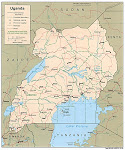
It's been another busy week in
Kilembe, but unfortunately we have a severe blood shortage and this is costing lives. The Ugandan hospitals get much of their blood from drives held at Universities, but school was in recess for 2 months and that caused a terrible shortage. So, many of our surgeries have had to be postponed and many of them were critical.
This lady came in with a severe infection on her scapula, under her skin. It was swollen and had no external evidence of the problem, but we operated on her and as we often do, got tons of pus out of the site. We leave it open like this for several days, until we are sure there are no signs of infection and then we take her back in for what they call secondary suture. We sutured her and she's doing fine and should go home in a few days.

This is Comfort and he is 7 years old. He is the face and classic picture of a gut perforation. We have so many of them here, because the villagers can't obviously afford bottled water, so they obtain their water from the local rivers and streams. These waters are infected with
Salmonelli typhii which causes Typhoid. If remained untreated, it causes the intestines to perforate and intestinal contents spill out into the abdominal cavity. Once they FINALLY come to the hospital, they are malnourished and have huge abdomens, filled with pus and feces.
Dr. Richard and I operated on this boy emergently one Saturday and got over a litre of feces from his belly. We really didn't know if he would live. Unfortunately, he is one affected by the blood shortage and although he needs surgery again, he is too unstable to undergo general anesthesia and as you can see, he's emmaciated and now has holes in his skin...possibly necrotizing fascitis. He's just now starting to eat and hopefully he will get well one day. It's not looking good though.

I really like this little boy. His name is Ishmael and he is 10 years old. He had an untreated infected fracture of his femur, so we repaired it in Surgery and placed pins for stabilization. He's been here in the hospital for a very long time, as the pin site became infected. He is better now and we were able to remove the pins this afternoon and placed a hip
spica cast. He should be able to go home soon.

This is Florence. She's been a nurse for 20 years and is EXCELLENT! She is my favorite nurse here in the hospital. This woman knows what she is doing and is very aggressive in caring for sick patients. She is very organized and I LOVE working with her!

This girl is 18 years old and has Type I Insulin-Dependent Diabetes. As is common with diabetics, she developed an open wound that would not heal and came to us for treatment. Her particular wound is actually on her butt, so that causes problems with sitting and ambulating. We were able to get all the infection cleaned up with daily cleaning with horrible Hydrogen Peroxide and dressing changes and she was finally discharged last week, after being her for weeks.

This poor man came to us with a large, weeping swollen area below his jaw. At first we thought it was an infection, but Dr. Edward and I operated on him and found large cancerous masses. We sent the tissue off for to Kampala to be analyzed, but we are pretty sure he has Lymphoma and therefore will be Stage 4 Cancer.

Unfortunately, there is not much we can do for this man, other than palliative care, as they don't have the resources to fight cancer the way we do in the U.S.A. His prognosis is very poor.

This is a cute little 4 1/2 year old boy who had been attacked by a dog and bitten on his arm a few days ago. He is smiling in this picture, but is really unhappy about having an IV and surgery on his arm.

These are his dog bites and as you can see, they are dirty and likely to become infected. The bites were so hard or the dog was so big, it actually broke his arm. We took him to Theatre to clean his wounds up and set his arm in a cast. He did very well and is happy on the Surgical Ward now and should go home soon.

This is Timothy and he is one of only 3 Nurse Anesthetists here at the hospital. He is very good and usually just works on weekends, but is called in all the time to assist during the week and at night. They are worked to death here and are grossly underpaid and
underappreciated by the Health District for which they work. The average nurse working full-time makes approximately $150/month.
This is our Supply Room/Break Room/Office, right off the Minor Surgery side of Operating Theatre. It's always strange to be eating our food while watching someone get operated on.

I am taking a quick lunch break. Dr. Edward is so nice and has lunch delivered to us every day we are operating, since we obviously can't leave to eat. The usual lunch consists of rice, beans, strange-tasting beef in a red broth,
matoke (unripe bananas that are mashed), sweet potatoes (served plain and boiled with no seasoning), and sometimes cooked cabbage,
ugali (millet porridge that looks like a red, congealed blob) or
posho (kind of like white, solidified grits with absolutely no flavor). The beans and rice are good though and that is all I will eat. The refrigerator to my left holds the blood for our surgeries, as well as our water and other drinks!

This is Dr. Robert
Masereka. He's only 27, but has been working here for some time. He's very smart and very good at his job. He's also somewhat of an expert on Malaria and often is called on to care for VIPs in the area. He's also one of my good friends here and we have lots of intense "discussions" about politics and such.
Doctors are also grossly underpaid. The average surgeon makes about $300/month. They also get a free house in which to live, but that is it.

This is Dr. Richard
Kajubi and a medical student doing a hernia repair. Richard is one of my best friends here and he is also about 27 years old. He's an excellent doctor and I love working with him on surgeries. He's been very patient teaching me to how to be a surgical nurse and we have both learned a lot by working with each other. He's very laid back and doesn't hesitate to give me the sutures to close someone up or to listen to my opinion on how to treat a patient. We make a great team in the O.R. and he often calls me in to work on emergencies with him.

This is Dr.
Wefula Edward and me operating on a severe hernia, in which a large percentage of a man's intestines had entered his scrotum and were stuck there and were causing a lot of pain.
Edward is the Medical Superintendent at Kilembe Mines Hospital and is a true workaholic. He's not only an expert Orthopedic Surgeon, but he's responsible for EVERYTHING about this hospital. He is very passionate about what he does and really cares about the patients. I never have heard him turn down "just one more patient" to operate on, even after a long day of surgery. He laughs at me, because I won't help him operate on bones, because I can't stand the sound of the hammering, chopping and drilling on human bodies. He also laughs and tells me I "give too much TLC to children", but he's the same way. He's very gentle and careful with all of his surgeries.

This cute little 2 month old baby girl came in with a fractured femur and had a hip
spica cast placed at another facility. This really irritated me, because it's very difficult to break baby's bones and the mother's excuse of "We dropped her", just didn't fly with me. No one even questioned this excuse though, as there is no system in place here to investigate cases of suspected child abuse. This baby was really good and allowed us to remove the cast and place another.

This is Ronald and I believe he is 8 years old. I was so worried about him when he first came in, as he had been in a motor vehicle accident and severely injured. He sustained a skull fracture, open head wounds, a fractured leg and severe road rash all over his body.
But...as you can see, he's happy and well and up walking around some now, with the help of a walker. He doesn't know how to speak English, but imitates everything I say and actually does a pretty good job. He was able to go home yesterday!

This is unbelievable. A group of thugs came to this little girl's home and assaulted her and her mother, while the dad/husband was at work. They severely broke this little finger and caused a wound to her cheek and eye.
The injury was a few days old when she presented and this is what it initially looked like, with deformity and gangrene present.

Unfortunately the finger could not be saved and had to be amputated.

This is her a couple of days after surgery and is doing very well and was discharged to home.

This is
Maclyn and she's 4 years old. She sustained a bad fracture to the growth plate of her femur/hip and had it treated at another facility. They did not treat it correctly and the bone popped back out of place and then healed in the incorrect position. Her right leg is at least a foot shorter than her right. Dr. Edward took her back into surgery and re-broke and tried to repair her hip and leg. He placed her in a hip spica cast and she's getting around pretty well with crutches, but I am afraid too much damage has been done and too much time has passed for her gait to ever be normal. She's really a cutie though and I played with her every day she was in the hospital.

This poor man came to us with this horrible growth hanging out of his neck. We were pretty sure from the beginning that it's advanced cancer, probably Lymphoma and cannot be treated. We biopsied the site in the OR and sent it to Kampala for analysis and then referred him for palliative care. The tumor is so large and invasive, that it's in his throat now and his speech is grossly affected. His prognosis is obviously not good.

This is a 15 year old girl who came in with severe burns to her entire head. I never did hear the story of how exactly this occurred, but when she first arrived, her face was swollen to twice this size and her eyes were completely swollen shut. She lost her hair, but only temporarily. She had to go to the OR repeatedly for burn debridement, but she's young and her burns seem to be healing quite well and without infection. She was discharged last week to home.
As you have seen, we have an exorbitant amount of children who present with very severe injuries and illnesses. Even though I am no longer on the pediatric or "Toto" Ward, I feel like I still am, since I am surrounded by children.


